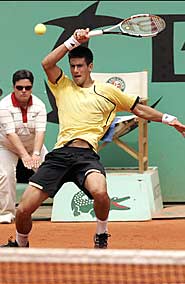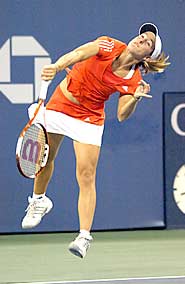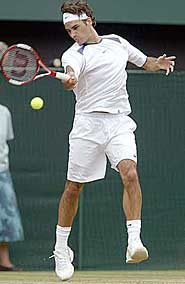|
TennisOne Lessons All-Court Games Doug Eng EdD, PhD Many of the best players in the Open Era have been all-court players. Today, Federer, Djokovic, Henin, and Mauresmo represent the all-court game. The modern all-court player is primarily an aggressive baseliner with a variety of shots topped off with a strong net game. The modern all-courter differs from the classic all-court player by using more power from the baseline and relying less on finish the point at the net. Though rare on the pro circuit, the classic all-courter still thrives at the club level, especially since power is less important.
There are several problems that limit the development of the all-court game:
Given that you might want to develop more all-court skills, what could you work on if you are a baseliner? Your teaching pro might have you practice dynamic approach shots or deep first volleys. You might also practice in some game situations.
Situational games are fun and allow you to practice in what physical educators call an open-skilled environment with variable practice. That means, simply, you are facing a real match-like situation with many possibilities. The most simple all-court game is playing doubles. Following are additional games, some of which are classics and others are new. Johnny Mac Obviously this game is named after John McEnroe who thrived in similar games and situations. Play a game using only half the court, either the left or right half, so all rallies must be straight. The doubles alley counts as part of the court. Spin the racquet to see who serves. The “server” feeds a courtesy short ball into the service box. The other player approaches and plays out the point. No lobs are allowed on the second hit by the feeding player at the baseline. This is a net vs baseline game with half a court which makes it easier to develop net skills. If the net player wins the point, that player goes back to the baseline and the loser feeds another short ball. If the netrusher loses the point, he or she goes back to the baseline and feeds a short ball to the winner of the rally. Play to 15 points, win by two.
Variation
Knock-Out Originally my teams used to play this as a three-player game. The third player replaces the loser. Two players start off with a baseline point on the singles court. The loser of the first point or baseline rally must feed a short ball around the service line where the opponent closes in and tries to win the point. If the netrusher wins the second point, he or she is awarded a game and the third player replaces the loser. If the netrusher loses the second point, the players go back to the baseline and start another baseline rally. You can never win a game from the baseline so you need to practice finishing off your points at the net. You may play with two or three players with the third player waiting at the net to substitute in. With two players, play a set to 6 games. Variations
Ghost Doubles This game is a crosscourt game. The rally must be in the deuce or ad court with the doubles alleys as good. A ball bouncing straight ahead or on the wrong side of the center line (draw an imaginary line from the center line to the center hash mark at the baseline) is out. You may rally from the baseline or you may try to close into the net. This game is great to improve your doubles as it allows you to cover the net more easily than singles. It also helps you develop groundstroke angles since you have the doubles alley. Advanced Version
One-On-One Doubles
This game is very similar to ghost doubles except the server must serve and volley (half-volleys are acceptable). If the server doesn’t get to the service line, he or she can be penalized a point. You can play a whole set with this format. You can also play with four players with player A1 playing only the deuce court against B1 and player A2 playing only the ad court against B2. That way, you can choose which serve return or which half-court you wish to practice on. In some areas, there are actually one-on-one doubles tournaments (check out www.oneononedoubles.com) Variations
Inside the Baseline Tennis
In this classic game, after the serve, neither player can stand behind the baseline. If a player steps behind the baseline (you can decide whether it will be one or both feet behind), he or she loses the point. So you must develop the skills to take the ball early. In addition, you may also have to volley from near the baseline (on deep balls) which force you to develop better skills. Finally, you can get to the net more easily. Play a 2/3 set to 4 games. 60 Foot Court Tennis (not shown) USTA is launching a terrific program named QuickStart which uses a 36 ft court and a 60 ft court. It is meant to develop junior players. In several European countries, even tournaments are being played using the smaller courts. Here, I won’t discuss the 36 foot court since that is primarily for younger juniors and beginners. However, the 60 foot court, intended for 9-10 year olds is actually quite useful for all ages. You can find the exact dimensions for the 60 foot court on the USTA website. Even though it is meant for junior development, this game is great for anyone wanting to improve his or her all-court skills. The smaller, shorter court forces you not to drive the ball for winners. You will develop more consistency and not get carried away with depth or power. Also, because the court is 18 feet shorter than the standard court, it is much easier to get to the net. And once you get to the net, your opponent has to choose a passing shot more wisely since a powerful drive can easily go long. Many public facilities may adapt the smaller courts so you may soon start seeing new lines on courts near you. Private clubs may be a different matter, however.
Get a Grip! Finally, one last game that forces you to get out of your comfort zone. This fun game requires you to play with one grip. When the famous golfer Seve Ballesteros was a kid, he used to go out on the golf course with just one club and play the entire course with that one club. You might play only with a continental grip, or an eastern backhand grip, or a two-handed grip, etc. The idea is to get you to explore your shot-making abilities better. If you want, you can combine this game with the 60 foot court (as it may be difficult to play on the full court using all your power and spin capacities). Play a game to 15 points. Then play another game with a different grip (that you don’t use often). The fun part is using the grip in situations you’d never thought possible, e.g., a eastern backhand grip on the forehand side. The tricky part is not cheating! It is very easy to let your grip slide over to what’s your comfort zone. You might actually pick up shots that Roger Federer or Fabrice Santoro use. Variations
Conclusions There are two ways of getting better in tennis. You can either focus on improving a shot until it is a major weapon. Or you can work on a variety of shots and patterns that allow you to outsmart your opponent. Everyone should spend time and aspire to develop two weapons (e.g., a strong serve and a great forehand), but realistically many of us won’t have the physical ability of a Maria Sharapova or a John Isner. So many club players should also work on all skills. Develop your game by practicing your skills in a game-like situation. It forces you to improvise and practice shot-making that makes tennis fun. The better athlete and shot-maker you are, the better the tennis player you are! Your comments are welcome. Let us know what you think about Doug Eng's article by emailing us here at TennisOne.
Doug Eng EdD PhD coaches men's tennis at Tufts University. During the summer, he directs at the Tennis Camps at Harvard. He has received divisional Pro of the Year honors from the PTR and USPTA and several national award. Doug completed the USTA High Performance Coaches program and frequently runs educational and training programs for coaches. Doug also writes and speaks on tennis and sport science. |




